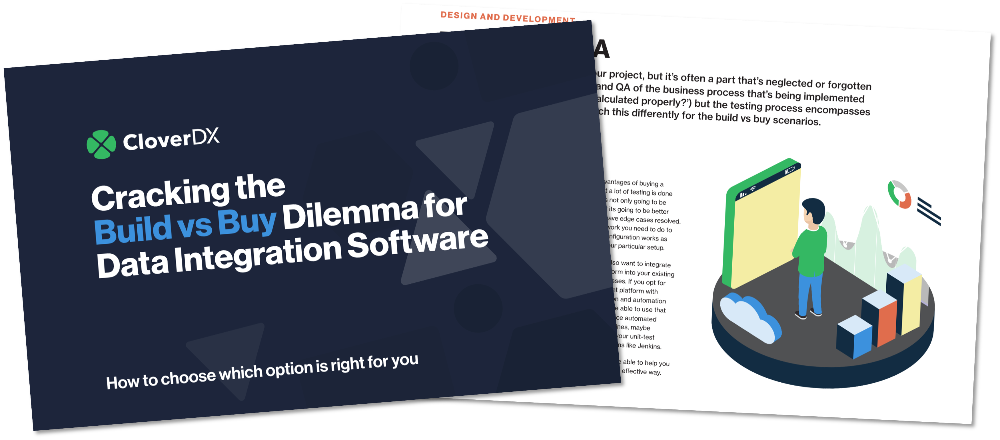What's in this webinar?
Getting your data to cloud is the first step of successful cloud migrations. Cloud service providers offer many different services for data storage and data management - understanding how they can be used and best practices around them is important when thinking about cloud data migrations.
In this video we look at:
- Options for storing files in AWS?
- Best practices for getting your data into various locations in AWS
- How CloverDX can help you migrate and manage your data in AWS cloud
Chapter 1: Why migrate? (2:10)
What drives organizations to move to cloud infrastructure? The increasing expense of supporting legacy applications; wanting to go mobile and provide access from anywhere; and the modern features provided by AWS are among the top drivers.
/2021-11-09_02%20Migrating%20your%20data%20to%20AWS%20(878%209538%206286).jpg?width=500&height=281&name=2021-11-09_02%20Migrating%20your%20data%20to%20AWS%20(878%209538%206286).jpg)
Chapter 2: Tools available to simplify migration to AWS (5:34)
While there are plenty of tools available to assist with a migration to cloud, AWS specifically, the choice can be overwhelming and perceived as an additional expense. We discuss which good tools are essential for success.
/2021-11-09_03%20Migrating%20your%20data%20to%20AWS%20(878%209538%206286).jpg?width=500&height=281&name=2021-11-09_03%20Migrating%20your%20data%20to%20AWS%20(878%209538%206286).jpg)
Chapter 3: Quick introduction to CloverDX (8:50)
Full stack data management platform for designing, automating, operating and publishing data and pipelines.
/2021-11-09_04%20Migrating%20your%20data%20to%20AWS%20(878%209538%206286).jpg?width=500&height=281&name=2021-11-09_04%20Migrating%20your%20data%20to%20AWS%20(878%209538%206286).jpg)
Chapter 4: CloverDX deployment options for both cloud and on-prem (11:15)
How should you think about using a data management platform - deploy on-prem or in the cloud? How to effectively combine a hybrid environment.
/2021-11-09_05%20Migrating%20your%20data%20to%20AWS%20(878%209538%206286).jpg?width=500&height=281&name=2021-11-09_05%20Migrating%20your%20data%20to%20AWS%20(878%209538%206286).jpg)
Chapter 5: The migration process - source location considerations (13:30)
Data locality significantly controls how the process needs to be planned. What are some of the key considerations?
/2021-11-09_07%20Migrating%20your%20data%20to%20AWS%20(878%209538%206286).jpg?width=500&height=281&name=2021-11-09_07%20Migrating%20your%20data%20to%20AWS%20(878%209538%206286).jpg)
Chapter 6: Migration process - Target considerations (16:20)
Although the target in this exercise is solely AWS, there still are a number of questions related to which AWS services you want to use, and how you are going to organize them.
/2021-11-09_06%20Migrating%20your%20data%20to%20AWS%20(878%209538%206286).jpg?width=318&height=179&name=2021-11-09_06%20Migrating%20your%20data%20to%20AWS%20(878%209538%206286).jpg)
Chapter 7: Moving files to AWS (18:45)
S3 for large volumes of unstructured files, or disk-style file system on EBS/EFS, you can seamlessly use either using the automation and shortcut components in CloverDX.
/2021-11-09_08%20Migrating%20your%20data%20to%20AWS%20(878%209538%206286).jpg?width=500&height=281&name=2021-11-09_08%20Migrating%20your%20data%20to%20AWS%20(878%209538%206286).jpg)
Chapter 8: Migrating data to AWS relational databases (24:15)
AWS has a rich selection of services for relational data. The key consideration is fully managed vs self managed, and then the volume you’re working with and the approach to migration.
/2021-11-09_09%20Migrating%20your%20data%20to%20AWS%20(878%209538%206286).jpg?width=500&height=281&name=2021-11-09_09%20Migrating%20your%20data%20to%20AWS%20(878%209538%206286).jpg)
Chapter 9: Migrating data to AWS data warehouses (29:42)
AWS offers natively Postgres-like Redshift. For data warehouse migrations, an ELT approach works best given the large amounts of data.
/2021-11-09_10%20Migrating%20your%20data%20to%20AWS%20(878%209538%206286).jpg?width=500&height=281&name=2021-11-09_10%20Migrating%20your%20data%20to%20AWS%20(878%209538%206286).jpg)
Chapter 10: Migrating data to/from cloud applications (35:38)
How to use APIs in both source and target scenarios to connect on-prem and cloud apps
/2021-11-09_11%20Migrating%20your%20data%20to%20AWS%20(878%209538%206286).jpg?width=500&height=281&name=2021-11-09_11%20Migrating%20your%20data%20to%20AWS%20(878%209538%206286).jpg)
Chapter 11: Summary (39:42)
There's a rich set of services available in AWS for you to store and use your data, and also a rich set of tools to help get your data from your source locations into your AWS targets.
/2021-11-09_12%20Migrating%20your%20data%20to%20AWS%20(878%209538%206286).jpg?width=500&height=281&name=2021-11-09_12%20Migrating%20your%20data%20to%20AWS%20(878%209538%206286).jpg)

Build vs buy: Cracking the dilemma
Should you continue investing into your homegrown DIY data integration solution? Or should you bite the bullet and invest in a commercial data platform?
If your ETL processes aren't as reliable, transparent or easy to maintain as you'd like, it might be time to start looking for a more robust solution.
This guide will walk you through every aspect of the decision so you can make an informed choice.


